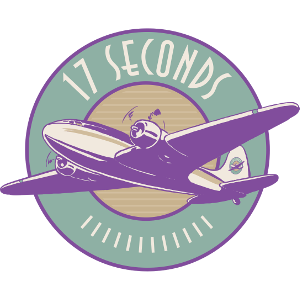17 Seconds #57 – A Publication For Clients And Other VIPs Of Clocktower.
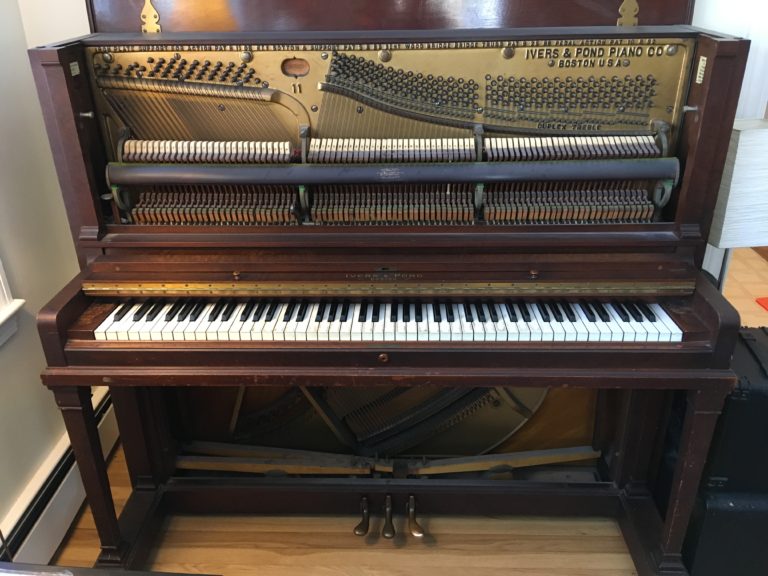
Our piano is nearly 100 years old. Recently, we had it tuned. Inside, there were many patent markings. This is (eventually) the story these patents tell.
Let’s start with the inscription:
SPECIALLY SELECTED
AND VOICED FOR
ARTHUR BELLINGER MUSIC
BATTLE CREEK, MICH
BY IVERS & POND PIANO CO.
A quick Internet search reveals the mailing address for this piano company, but the building no longer appears to be there. (An older building numbered 18 1/2 does appear to be the right age.)
ARTHUR BELLINGER MUSIC
19 Michigan Ave. N
BATTLE CREEK, MICH 49014
Similarly, the Boston-based Ivers & Pond piano company was one of many companies that failed to survive the Great Depression, continuing on in name only. From the Antique Piano Shop website:
“Ivers & Pond was an expensive, well made piano, and they were often made of lavish and exotic woods with amazing detail to the cabinet work. Internally, these instruments would rival any manufacturer for excellence in design and quality. Like so many other renowned piano makers, Ivers & Pond was consolidated into the Aeolian-American Corporation during the Great Depression years.”
My grandfather, George Eugene Heels (1904-1974), and my grandmother, Vera Maude (Ray) Heels (1903-1995), purchased the piano while living in Michigan, circa 1926. It was delivered to their house via horse and buggy. It has moved many times: to Massachusetts, Maine, New Hampshire, and back to Massachusetts.
I grew up playing this piano in Ashland, MA (1967-1972), Cape Elizabeth, ME (1972-1984), and Acton, MA (2007-PRESENT), after inheriting it from my brother, Mark. Whenever I move to a new home, I look first for where to put my piano. (I have always had a piano, I have not always had this piano.) Ideally, your piano should not be on an exterior wall (too much heat variation) or next to a radiator (ditto).
My memory is that Ivers & Pond upright grand pianos are strung with higher tension than most uprights – and that they keep their tune exceptionally well. Still, we had not tuned it since moving into this house in 2013. I remember watching and listening to a blind man tune the piano in Cape Elizabeth in the 1970s. This tuning was done by Artie Doran of Natick on the recommendation of our longtime piano teacher, Yale Beebee.
Inside the piano, embossed in metal (zoom in on the above photo) and printed on a label (see photo below), is the following information:
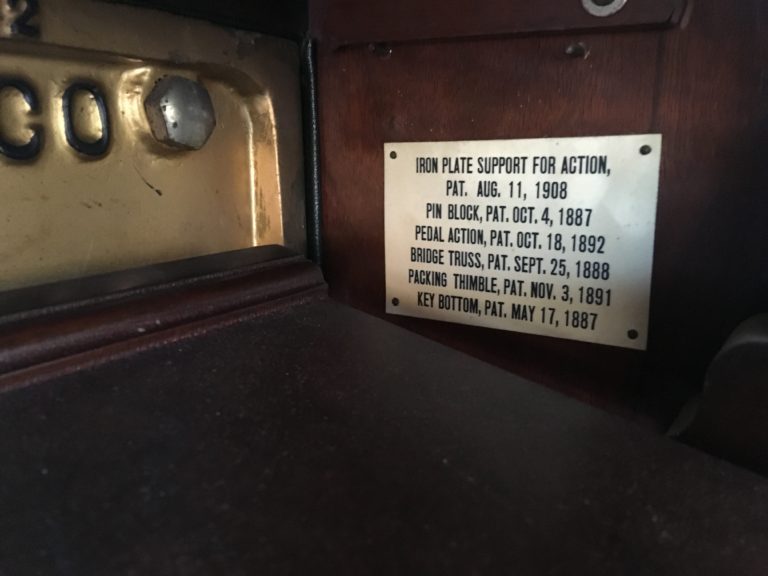
IVERS & POND PIANO CO
BOSTON USA
DUPLEX TREBLE
[SERIAL NUMBER] 57589KEY BOTTOM & SUPPORT
PAT. 5888 (1887-05-17)PIN BLOCK
PAT. (1887-10-04)BENT WOOD BRIDGE BRIDGE TRUSS
PAT. 92588 (1888-09-25)PACKING THIMBLE
PAT. (1891-11-03)PEDAL ACTION
PAT. 10892IRON PLATE SUPPORT FOR ACTION
PAT. 81108 (1908-08-11)
That’s two trademarks and six patents, but the patent numbers look all wrong, so let’s start with the trademarks.
Ivers & Pond Piano Trademarks
There have been five “Ivers & Pond” trademarks filed, under multiple owner names, from 1958 to 2018. Only the 2018 application is still active (live).
1. IVERS & POND (app. no. 72051912)
Filing Date: May 19, 1958
Owner: AEOLIAN CORPORATION
http://tsdr.uspto.gov/#caseNumber=72051912&caseType=SERIAL_NO&searchType=statusSearch2. IVERS & POND (app. no. 72226746)
Filing Date: August 30, 1965
Owner: CITICORP INDUSTRIAL CREDIT, INC.
http://tsdr.uspto.gov/#caseNumber=72226746&caseType=SERIAL_NO&searchType=statusSearch3. IVERS & POND (app. no. 76353594)
Filing Date: December 27, 2001
Owner: BALDWIN PIANO, INC.
http://tsdr.uspto.gov/#caseNumber=76353594&caseType=SERIAL_NO&searchType=statusSearch4. IVERS & POND (app. no. 86342599)
Filing Date: July 21, 2014
Owner: Gibson Brands, Inc.
http://tsdr.uspto.gov/#caseNumber=86342599&caseType=SERIAL_NO&searchType=statusSearch5. IVERS & POND (app. no. 87764496)
Filing Date: January 22, 2018
Owner: Gibson Brands, Inc.
http://tsdr.uspto.gov/#caseNumber=87764496&caseType=SERIAL_NO&searchType=statusSearch
I did not find any trademark filings for “Duplex Treble,” but this feature is described in a 1906 Ivers & Pond advertisement as: “the very latest device for increasing tone vibration in the treble.”
Ivers & Pond Piano Patents
Based on the age of the Ivers & Pond company and the dates of the patents, the patent numbers should be six digits long. Perhaps the listed numbers are application numbers or something else, but they are not issued patent numbers. Fortunately, dates were also provided, which made finding the claimed patents a bit easier. The USPTO patent database is only partially digitized: full text from 1976-PRESENT, images only before 1976. Also, the earliest patents were not numbered at all, further complicating matters. Third party databases can sometimes help, but the metadata is inconsistent and unreliable (which, by the way, is one of the reasons why Clocktower does not do its own patent searches but relies on the biggest and best patent search firm in the country). By examining the dates, I was able to determine that they are the dates the patents issued, not the dates they were filed. The dates were all Tuesdays, and the USPTO issues patents on Tuesdays (odd, I know).
Here are the six decoded patents listed in my piano:
1. KEY BOTTOM & SUPPORT
PAT. 5888 (1887-05-17)
= U.S. Patent 363,240, Key Board For Piano Fortes, W. H. Ivers2. PIN BLOCK
PAT. (1887-10-04)
= U.S. Patent 371,069, Piano-Forte, W. H. Ivers3. BENT WOOD BRIDGE BRIDGE TRUSS
PAT. 92588 (1888-09-25)
= U.S. Patent 389,966, Bridge For Piano-Fortes, W. H. Ivers4. PACKING THIMBLE
PAT. (1891-11-03)
= U.S. Patent 462,257, Boxing Thimble For Packing Furniture, W. H. Ivers5. PEDAL ACTION
PAT. 10892 (1892-10-18)
= U.S. Patent 484,500, Piano Pedal, W. H. Ivers6. IRON PLATE SUPPORT FOR ACTION
PAT. 81108 (1908-08-11)
= U.S. Patent 896,066, Piano Action Supporting Means, Emil Sander
Of these, my favorite is #4, the “Packing Thimble” patent:
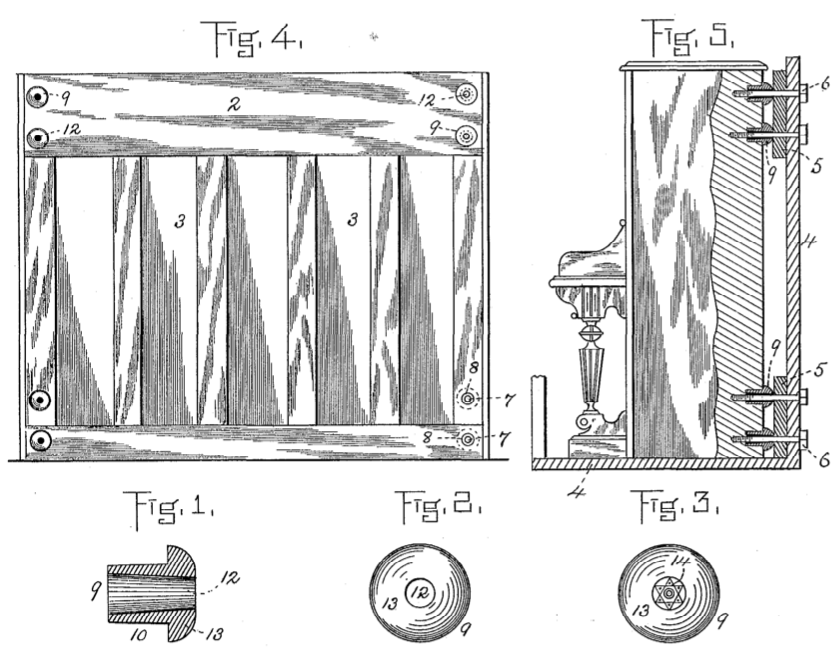
The others are all directed to making better/faster/stronger pianos. But the “Packing Thimble” patent describes a system for packing and moving pianos, which would be a very powerful patent to own! I would have loved to be in the meeting where Ivers and his lawyer decided to file that patent. “OK, the competition is designing around our piano patents, but we can make it more difficult for them to deliver their competing pianos. Let’s patent the packing thimble!” Or something like that.
Additionally, this patent is not listed in my piano, but it shows the structure of the back of a typical Ivers & Pond piano:
U.S. Patent 375,491, Piano-Forte, W. H. Ivers (1887-12-27)
While trying to decode the patents listed in my piano, I also came across many other interesting patents, many of which are for products that we now take for granted:
- U.S. Patent 363,213, Hand Or Jack Plane
- U.S. Patent 363,239, Coin Tray
- U.S. Patent 363,281, Stove
- U.S. Patent 363,332, Device For Attaching And Detaching Electric Lamps
- U.S. Patent 371,128, Combined Step Ladder And Chair (which I thought was Ben Franklin’s invention)
- U.S. Patent 371,141, Needle
My Old Piano Is New Again
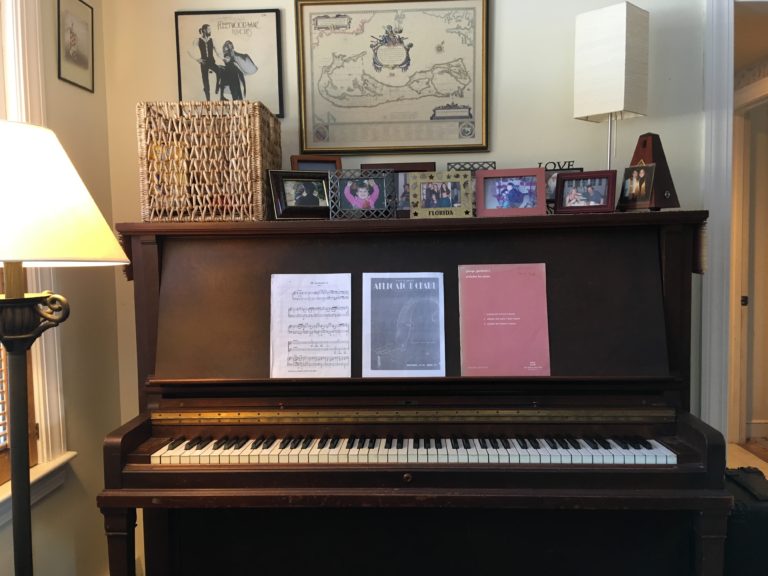
The moral of this story is that you should tune your piano every six months. And you should do a good job marking your patented products with your actual patent numbers. Otherwise somebody will write an article like this one. Thanks for making it all the way to the end. (Hi, Mom!)
17 Seconds is a publication for clients and other VIPs of Clocktower Law. Email version powered by MailChimp and the beat of a different keyboard player.
